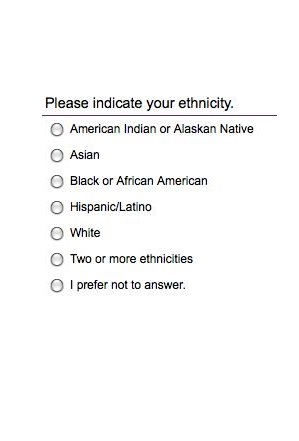“What is your race?” Here I am, hoping that the survey I’m taking allows me to choose more than one answer or select “Two or more races”. I define myself as mixed or biracial. My mother is 100% Indian. No, not Native American… INDIAN, from INDIA. My father was white, which I presumed to be Italian, German, and Polish. I grew up in an almost completely White-Catholic town, so you can imagine that I didn’t really feel like I fit in (I felt this way for other reasons, too, but that’s another story). Before becoming a board member for PAISOC, out in the world I defined myself as “basically white”, despite being half non-white. My slightly dark complexion and dark hair had most people assuming I was Hispanic/Latinx, even putting me in situations where I was assumed to speak Spanish. I even got to the point where I took a DNA test. From this test I discovered that the tales of my ancestry had been fairly accurate, but that did not give me any more guidance on how to answer a simple survey question.
The United States Census Bureau defines standards on race and ethnicity by categorizing race into five groups: White, Black or African American, American Indian or Alaska Native, Asian, and Native Hawaiian or Other Pacific Islander. For the Census 2000, an option to self-identify race was added (hooray!), which is reported as “Two or More Races”. However, the Census also asks a question about ethnicity, providing two options: Hispanic or Latino and Not Hispanic or Latino. They define “Hispanic or Latino” as a person of Cuban, Mexican, Puerto Rican, South or Central American, or other Spanish culture or origin regardless of race. There is much debate about this surprising fact, and about race/ethnicity in general [1] [2] [3].
Okay, so we’ve figured out which categories I fit into: White and Asian. But Asian… really?? I don’t feel like I’m Asian. I feel like I am Indian. Maybe I fit into South Asian? Who knows…
NBC News published an article in 2015 that explored how the definition of “Asian-American”. Their findings display the dilemma I face. They asked whether certain ethnic groups (here we go with the ethnicity thing again) – Chinese, Indians, Filipinos, Vietnamese, Koreans, Japanese, Cambodian, Laotian, Hmong, Pakistanis, Bangladeshis, and Native Hawaiians and Pacific Islanders – were likely to be Asian. Unsurprisingly, they found that, among whites, 41% and 45% stated Indians and Pakistanis, respectively, were not likely to be Asian. “Americans — including Asian Americans — draw a sharp boundary between Asian and non-Asian that separates East Asians (Chinese, Korean, and Japanese) from South Asians (Indians, Pakistanis, and Bangladeshis) and, to a lesser extent, Southeast Asians like Filipinos.”


The Pew Research Center in Washington, D.C. explored opinions of multiracial people , finding that almost 7% of U.S. adults in 2015 had at least two races in their background (see Figure 1). Another interesting result is how close multiracial individuals feel to their single-race relatives (see Figure 2). Another article from FiveThirtyEight discussed the Pew findings, but included the distribution by age, finding that younger Americans are more multiracial (see Figure 3). A Brookings blog post states that the United States is heading towards a “minority white” population by 2045, based on Census projections in 2018. They mention that “the greatest growth is projected for multiracial populations, Asians, and Hispanics with 2018–2060 growth rates of 176, 93, and 86 percent, respectively”. Overall, it seems that awareness of biracial and multiracial populations are growing.

Does race really matter? Scientifically, no. Socially, more yes than no. No matter the answer, data will still need to be collected. Thoughts will still need to be simplified. Differences will need to be categorized. Is the solution to “choose all that apply”? Maybe, but then the data become murky and the results are difficult to understand. Is the solution to self-report? Maybe, but then human error comes into play. As more things improve, I see a better future for classification, identity, and data collection. What will help this is becoming better scientists, not changing who we are or how we fit in.
“When we can’t fit a square peg into a round hole, we’ll usually blame the peg”. – Nate Silver, The Signal and the Noise
Bianca Doone is a PhD student in Biostatistics at the University of Massachusetts Amherst. She can be reached at bianca@paisoc.org or on Twitter @bndoone.

